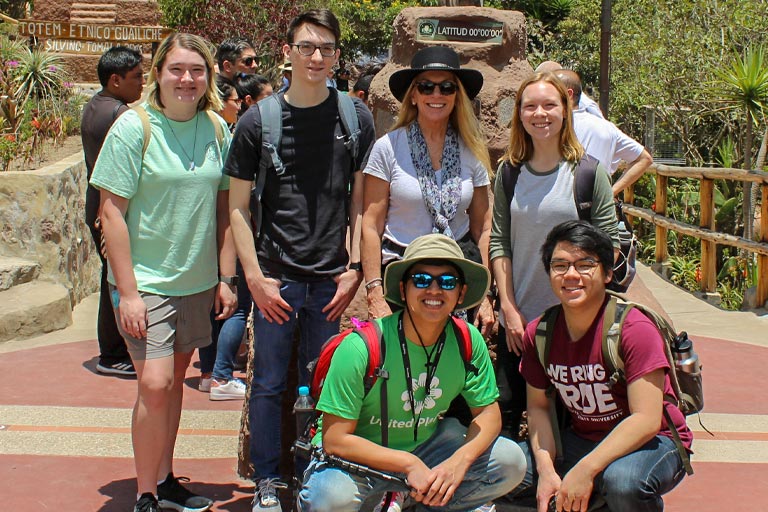Trip Report: Alternative Spring Break in Ecuador
by Judith Mallory
The Tickle College of Engineering’s Alternative Spring Break of 2019 took place from March 16–24 in Quito and San Clemente, Ecuador. It was the third trip to Ecuador and the 23rd for the Global Initiatives Program. Participating in the trip were sophomore electrical engineering major Hoangnha Vo, sophomore computer engineering majors Phillip Chu, and Megan Stanton, freshman civil engineering major Samantha Jurek, and senior industrial engineering major Josh Presnell. Judith Mallory, TCE International Coordinator, led the trip, whose accommodations were provided by United Planet of Boston.
» Read Phillip Chu’s student trip report
» Read Samantha Jurek’s student trip report
» Read Josh Presnell’s student trip report
» Read Megan Stanton’s student trip report
» Read Hoangnha Vo’s student trip report
The group arrived in Ecuador at the Mariscal Sucre International airport, located about 45 minutes outside of Quito, purportedly the highest world capital, situated at 9,350’ above sea level. Quito, whose name comes from the ancient Tsafiqui word Quitsato, or “middle of the earth,” is one of only two capitals in the Americas founded by indigenous people, the other being Mexico City. Quito is located on the eastern slopes of Pichincha, an active stratovolcano in the Andes Mountains.
Mainland Ecuador, considered a tropical country, contains a total of 28 volcanoes. Comparable in size to the state of Nevada, Ecuador is made up of four regions: the Galapagos Islands, the coastal region, the Amazon region, and the highlands. The Amazon section of the country covers almost half of the land mass of the country, yet is home to only about 5% of the population.
About 95% of the country’s population is of the Roman Catholic faith, and there are fourteen indigenous groups in residence. Spanish is the official language, with Quichua being the most common of the many indigenous dialects. Mestizos, those of mixed native and Spanish ancestry, make up about 65% of the population, indigenous tribal people about 25%, and Afro-Ecuadorians about 3%. High inflation and a financial crisis in the year 2000 resulted in the adaptation of the U.S. Dollar as the official currency, replacing the sucre.
Ecuador has the highest population density of all of the South American nations, with oil and petroleum accounting for over half the export earnings of the country. About 15 million people live in Ecuador, with about three million of those living in Quito, the original UNESCO World Cultural Heritage Site.
One of the outings taken by the group was to the nearby town of San Antonio de Pichincha; this is where the French Geodesic Mission came in 1735 to measure the earth, and declared what they concluded to be the site of the equator. It was later determined by more sophisticated GPS technology that the actual location of the equator is at the site of what is now the Intinan Solar Museum, nearby.
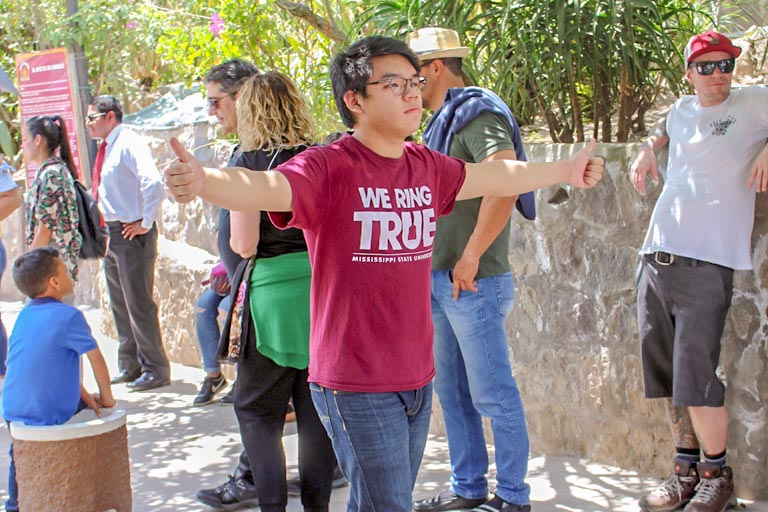
The Intinan featured interactive exhibits showing how the Incas determined the location of the middle of the earth, science experiments including balancing an egg on a nail and the effects of the Coriolis force on earth. The native guide explained that energy is a crucial component of the practices of native societies, and of great historical interest to them. Guinea pigs which live on the site are there to “remove bad energy” that may be present or brought in by visitors. The guide talked about the regions of the country and practices common to the cultures therein. A display of several authentic shrunken heads is evidence of honoring the dead of certain indigenous populations, including a young boy and a tribal shaman. A shrunken head of an endemic sloth was on display to illustrate how the tribes perfected the practice. A replica of a native hut and small burial ground were part of the tour. The museum contains a solar clock, an anthropological totemic forest of the Andean cultures, and native flora and fauna. Naturally, the equator runs through the center of the site. Assertedly, Ecuador is the only site on the planet where the equator crosses over highlands; on the rest of the earth’s surface, it crosses through jungle or ocean.
The walking tour of Old Town Quito began at the magnificent Basílica del Voto Nacional, known locally as the Cathedral. Of the Gothic style, and whose façade is adorned with gargoyles representing animals of mainland Ecuador and the Galapagos, including turtles, frigate birds, iguanas, and caiman, which are cousins of the crocodile, it is the oldest neo-Gothic Basilica in the Americas. Construction began in 1887, it remains technically “unfinished.” Legend has it that upon completion of the structure, the world will come to an end. The Old Town is composed primarily of Andalusian style architecture, including cathedrals, monasteries, convents, and old government buildings.
The principal square of Quito was included on the route, the Plaza de la Independencia. Colloquially known as Plaza Grande, it is typical of the large, public squares of major Latin American cities, flanked by government buildings and the original bishops’ residence. Its main feature is the monument to the independence heroes of August 10, 1809. Elections for many public offices excluding the presidency were approaching. Many residents were out in the square to campaign or listen to presentations being given by candidates.
Interestingly, the timing of the visit coincided with the Spring Solstice, a holiday of significance for indigenous cultures. The indigenous celebrate this occurrence, known in the Quechua language as Pawkar Raymi, loosely meaning celebration of the garden. Both solstices and equinoxes are cause for celebration; the solstices are masculine holidays primarily associated with the sun while the equinoxes are feminine holidays primarily associated with the moon. Parades and large communal gatherings, often with food, are common features of these celebrations.
Prior to these holidays, women in the community make chicha de jora, a fermented drink made of corn. Festival participants pass around hollowed gourds containing the drink. The Pawkar Raymi honors Pachamama, or Mother Earth. The spring is a time of harvest in the Southern Hemisphere and along the Equator. In some Andean communities, this festival is celebrated alongside Mardi Gras. In this way, native beliefs are intertwined with those of Catholicism. This is an example of syncretism, quite common in the Latin American nations where Spaniards brought Catholicism to indigenous residents who were practicing native traditions. It is not uncommon to see both side-by-side.
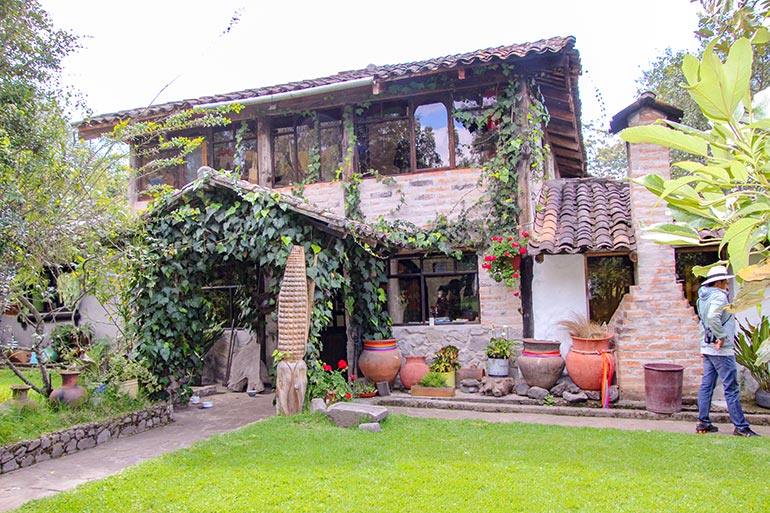
The service portion of the trip took place in the remote Andean town of San Clemente. An indigenous family named the Guatemals hosted the group. Mr. Guatemal serves as the president of the parrochia, a position roughly equivalent to a town mayor. Edison, the Guatamal’s youngest son, led the group on a nature hike through a wooded area known for its medicinal herbs and plants. An area used in sacred rituals was noted along the path. Children are not allowed to play here, in order to show respect for the culture. The trail was narrow, steep, and circular, ending up back at the family home.
After the nature walk, Edison showed the group the site of a “natural clock,” cruz Andina, or chacana. This was essentially a huge sundial, constructed of bricks and resembling the Southern Cross constellation. It was an approximately 15’ in circumference circle with a large pole standing in the center. The shadow cast by the sun falls into one of twelve segments, each of which designates a month, and dictate farming schedules as far as planting and harvesting. The center of the circle contains a cross of the brick placement, representing the two equinoxes in one direction and the two solstices in the other. The bricks are arranged to denote the twelve months of the year, and it is into these sections where the shadow would be cast on any particular day.
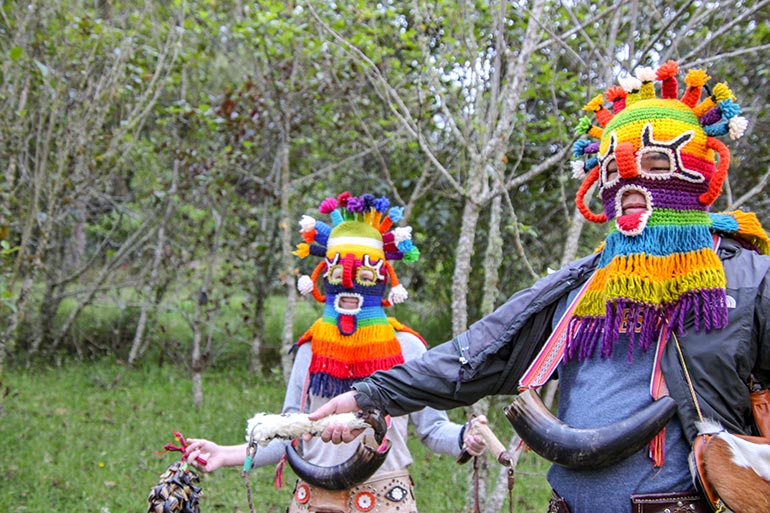
After the explanation, the group was led in a demonstration of a Raymi (described earlier.) Two students put on zamarro, which are chaps made of sheepskin. They also wore chivos, which are knitted, two-faced masks, which pull over the head and represent the duality of the Sun and moon, day and night, good and evil, and so forth. The twelve tassels atop each mask represent the twelve months of the year. In the traditional ceremony, the aya huma, or dance leaders, wear the masks to represent the spirits. For the demonstration, the leaders danced around the exterior of the chacana, carrying whips fashioned from animal legs, and the dancers carried instruments made of animal hooves and claws, which were shaken like maracas. During the dance, Edison provided music on the bandolin, an instrument native to Ecuador, having fifteen steel strings.
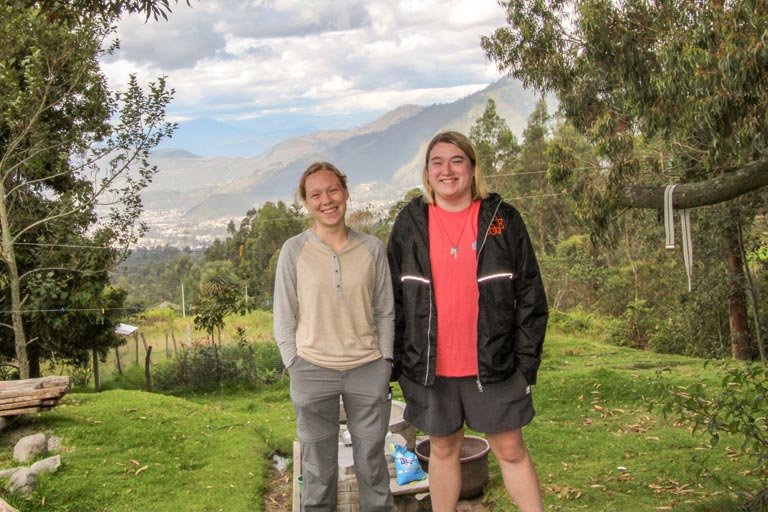
The service portion of the trip was threefold: the first task was to excavate an area near the house for the location of a future oven. The oven will be used for making bread for the community as well as for training people in the community in the skills of baking. A second job was at the nearby school and community center. Customarily, spectators of area soccer matches sit on a hillside above the field. Some erosion has caused parts of this area to be unsuitable for this purpose; the TCE group helped smooth out the earth and moved sections of sod on top, to control future wearing-away of this area. While on the grounds, the students also planted native trees. The third project was to build a bench at the homestead. An original bench was in need of replacement. This provides a large sitting area outdoors on the lawn. The students finished off this project by painting an orange “Power T” on the bench’s back, along with their initials.
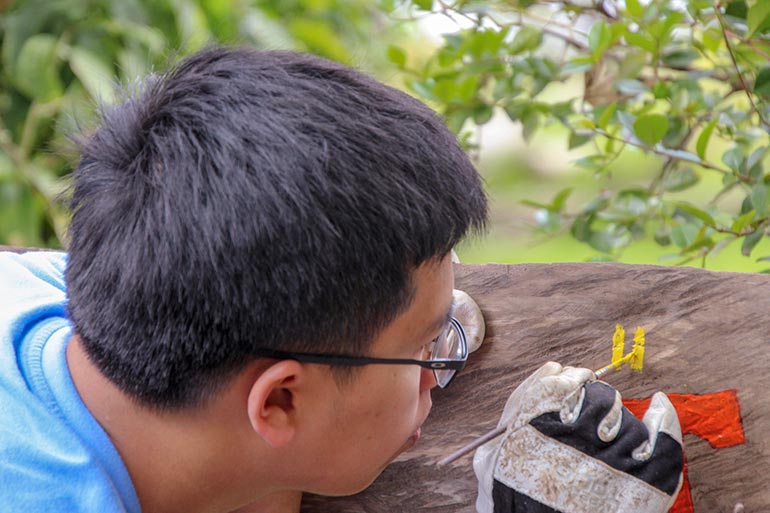
One of the activities at the home was an embroidery lesson, offered by the lady of the house and her daughter-in-law. All group members were given a piece of white cloth, burned on the edges to prevent fraying, and instructed to draw a design of their choice on it. At this point, the ladies demonstrated how to embroider the design. The students worked on this project in their free time for several days.
Another afternoon was spent in the kitchen, learning to prepare dinner for that night. Students washed, peeled, minced, sliced, chopped, arranged, blended, dredged in flour, and cooked the various items on the menu. These included a chile sauce, ensalata, chifles, or fried plantain chips, papas saltear, or potatoes, a lentil and vegetable soup, and fried tilapia. A power outage during the process led to some creative arrangements of flashlights and headlamps around the room, in order that the preparation could continue. Fortunately, the stove was powered by gas, so the fish and vegetables cooked without interruption.
On the way to and from the country location, the group traveled through small towns with distinct cultures and practices. For example, in one town along the route, all male residents, including children, wear white pants and have their hair fashioned in a single, long braid. Other examples include Iluman, which is known for its shaman, Peguche is known for weaving. Another of the small nearby towns is known for biscuit production, another for dairy products, and still another, for hat making. The proprietress of the hat shop invited the group in to see the millinery operations taking place in the rear of the store.
An outing nearby San Clemente was to the town of Otavalo with the Imbabura volcano visible in the background. Otavalo is known for its indigenous market, purportedly the largest of its kind on the South American continent. Many merchants bring their wares on a regular basis to this location and offer them for sale. Primarily a textiles market, one can find clothing, table linens, blankets, sweaters, hats, and even finger puppets for sale, all made by Ecuadorian artisans. In addition, shoppers can find items of ceramic, wood, silver, leather, and metal products. Along with the work of the Otavaleños, one may also find work by other groups at the Otavalo market including: Kichwa Cayambis, Kichwa Caranquis, Afro Ecuatorianos, and Mestizos.
While in town, the students got to visit a cable car similar to the gondolas and ski lifts of mountain towns. The Teleférico was opened in 2005, and travels up and down Volcán Pichincha, or the Pichincha Volcano, one of the mountains surrounding the city. At the top is Cruz Loma; from this point, one may simply view the city or continue hiking further up the mountain. Cruz Loma sits at about 13,000’ above sea level.
Another cultural visit was to the Fundacion Guayasamin, an art museum devoted to the works of the national artist of Ecuador, Oswaldo Guayasamin (1919 – 1999), who bequeathed his estate to the country upon his death. A painter and sculptor of Ibero-America, Guayasamin was a prolific artist, social activist, and humanitarian. On the Integration Plaza approaching the museum building, one could observe quite a few of his sculptures. The museum itself, known as La Capilla del Hombre, the Chapel of Man, was Guyasamin’s creation and tribute to the American pre-Columbian.
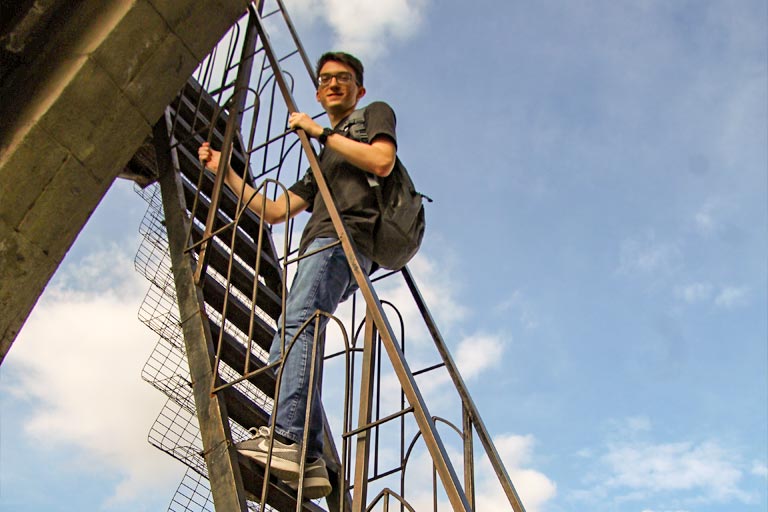
The remainder of the activities centered around exploring Quito prior to leaving the country for a late-night flight. Due to the altitude, flights bound for the United States don’t leave Quito until after 10.00 p.m.
